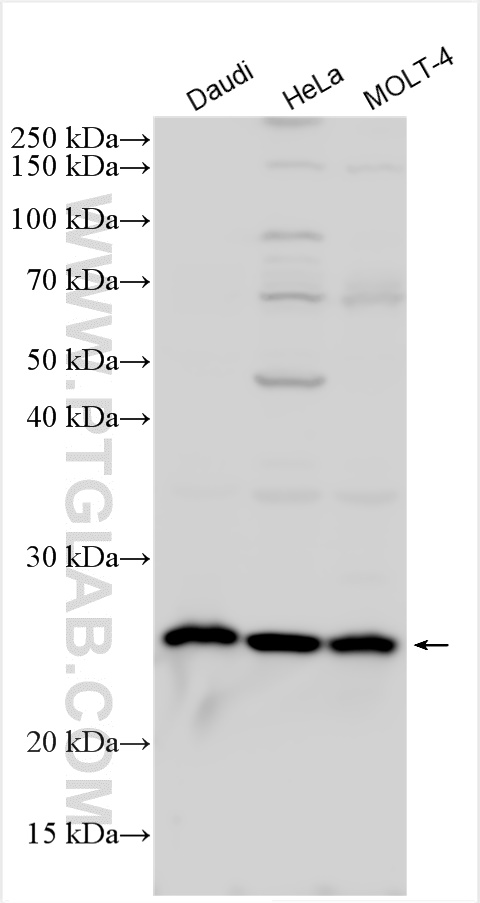验证数据展示
经过测试的应用
| Positive WB detected in | Daudi cells, HeLa cells, MOLT-4 cells |
推荐稀释比
| 应用 | 推荐稀释比 |
|---|---|
| Western Blot (WB) | WB : 1:500-1:3000 |
| It is recommended that this reagent should be titrated in each testing system to obtain optimal results. | |
| Sample-dependent, Check data in validation data gallery. | |
产品信息
24495-1-AP targets IL-17B in WB, ELISA applications and shows reactivity with human samples.
| 经测试应用 | WB, ELISA Application Description |
| 经测试反应性 | human |
| 免疫原 |
CatNo: Ag21453 Product name: Recombinant human IL-17B protein Source: e coli.-derived, PET30a Tag: 6*His Domain: 23-180 aa of BC113925 Sequence: RSPKSKRKGQGRPGPLAPGPHQVPLDLVSRMKPYARMEEYERNIEEMVAQLRNSSELAQRKCEVNLQLWMSNKRSLSPWGYSINHDPSRIPVDLPEARCLCLGCVNPFTMQEDRSMVSVPVFSQVPVRRRLCPPPPRTGPCRQRAVMETIAVGCTCIF 种属同源性预测 |
| 宿主/亚型 | Rabbit / IgG |
| 抗体类别 | Polyclonal |
| 产品类型 | Antibody |
| 全称 | interleukin 17B |
| 别名 | Cytokine Zcyto7, IL 17B, IL 20, IL17B, IL-17B, IL20, interleukin 17B, Interleukin 20, NIRF, ZCYTO7 |
| 计算分子量 | 180 aa, 20 kDa |
| 观测分子量 | 24 kDa |
| GenBank蛋白编号 | BC113925 |
| 基因名称 | IL-17B |
| Gene ID (NCBI) | 27190 |
| RRID | AB_3669439 |
| 偶联类型 | Unconjugated |
| 形式 | Liquid |
| 纯化方式 | Antigen affinity purification |
| UNIPROT ID | Q9UHF5 |
| 储存缓冲液 | PBS with 0.02% sodium azide and 50% glycerol, pH 7.3. |
| 储存条件 | Store at -20°C. Stable for one year after shipment. Aliquoting is unnecessary for -20oC storage. |
背景介绍
The interleukin (IL)-17 superfamily, a relatively new family of cytokines, consists of six ligands (from IL-17A to IL-17F), which bind to five receptor subtypes (from IL-17RA to IL-17RE) and induce downstream signaling. IL-17B was originally described as increased during intestinal inflammation. Moreover, it stimulates TNF-α and IL-1β production by the human monocytic leukemia THP-1 cells and promotes neutrophil migration upon intraperitoneal administration, suggesting a pro-inflammatory role. More recent findings strongly suggest a role for the IL-17B/IL-17RB pathway in tumorigenesis.
实验方案
| Product Specific Protocols | |
|---|---|
| WB protocol for IL-17B antibody 24495-1-AP | Download protocol |
| Standard Protocols | |
|---|---|
| Click here to view our Standard Protocols |


